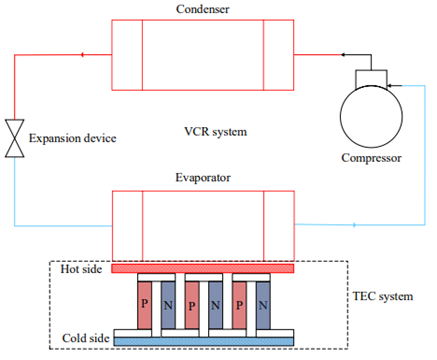Thermal Analysis to Achieve Low Temperature with Thermoelectric Cooling System
DOI:
https://doi.org/10.58564/IJSER.2.3.2023.87Keywords:
Thermoelectric cooler; mathematical modelling; Seebeck effect; Peltier effect; thermoelectric cooling systemsAbstract
Thermoelectric coolers (TEC) are devices that conversion of electrical power into a temperature gradient. TEC modules have the benefits of high dependability, small dimensions, lightweight, absence of mechanical moving parts and working fluid. Thermoelectric cooling systems have experienced significant utilisation in recent years. These technologies have been used in automobiles to cool and maintain the quality of goods during transportation and in portable cooling bags, computers, and medical apparatus. The TEC manufacture datasheet only offers limited data on characteristics and maximum parameters, which is insufficient for studying thermoelectric systems. This paper presents an analytical modelling methodology that provides a direct method for assessing the performance of module parameters and determining the fundamental thermal physical parameters of a TEC. Furthermore, this article outlines the procedure for choosing the appropriate TEC module from a selection of three options to integrate it with a vapour compression refrigeration (VCR) system. The objective is to attain low temperatures while reducing power consumption and improving performance. The findings indicates that The TEC1-12706 module was the most suitable option among three different types of TEC modules for integration with the VCR system to achieve low temperatures. This choice was based on its lower power consumption than the TEC127010 and TEC127015 modules, resulting in 36.5% and 59.3% energy savings, respectively. Additionally, the heat dissipation from the hot side of the TEC12706 is lower than the TEC12710 and TEC12715 modules by 32.2% and 59%, respectively.
References
H. Lee, Thermal design: heat sinks, thermoelectrics, heat pipes, compact heat exchangers, and solar cells: John Wiley & Sons, 2022. DOI: https://doi.org/10.1002/9781119686040
S. B. Riffat and X. Ma, "Thermoelectrics: a review of present and potential applications," Applied thermal engineering, vol. 23, pp. 913-935, 2003. DOI: https://doi.org/10.1016/S1359-4311(03)00012-7
T. Yin and Z.-Z. He, "Analytical model-based optimization of the thermoelectric cooler with temperature-dependent materials under different operating conditions," Applied Energy, vol. 299, p. 117340, 2021. DOI: https://doi.org/10.1016/j.apenergy.2021.117340
S. M. Pourkiaei, M. H. Ahmadi, M. Sadeghzadeh, S. Moosavi, F. Pourfayaz, L. Chen, et al., "Thermoelectric cooler and thermoelectric generator devices: A review of present and potential applications, modeling and materials," Energy, vol. 186, p. 115849, 2019. DOI: https://doi.org/10.1016/j.energy.2019.07.179
tetech. Peltier - Thermoelectric Cooler Modules. Available: www.tetech.com
Z. Luo, "A simple method to estimate the physical characteristics of a thermoelectric cooler from vendor datasheets," Electronics cooling, vol. 14, pp. 22-27, 2008.
B.-J. Huang, C. Chin, and C. Duang, "A design method of thermoelectric cooler," International journal of Refrigeration, vol. 23, pp. 208-218, 2000. DOI: https://doi.org/10.1016/S0140-7007(99)00046-8
Z. G. Q. R.P. Fu, W.Q. Tao , X.B. Zhu, J.R. Liu "Experimental and numerical study on performance of hybrid refrigeration system that combines vapor compression and thermoelectric systems," Applied Thermal Engineering, vol. 194, 2021. DOI: https://doi.org/10.1016/j.applthermaleng.2021.117107
D. A. J.G. Vián "Development of a hybrid refrigerator combining thermoelectric and vapor compression technologies," Applied Thermal Engineering, vol. 29, 2009. DOI: https://doi.org/10.1016/j.applthermaleng.2009.05.006
A. M. D. Astrain*, A. Rodríguez, "Improvement of a thermoelectric and vapour compression hybrid refrigerator," vol. 39, 2012. DOI: https://doi.org/10.1016/j.applthermaleng.2012.01.054
E. A. Engin Söylemez , Ayhan Onat "Experimental analysis of hybrid household refrigerators including thermoelectric and vapour compression cooling systems," vol. 95, pp. 93-107, 2018. DOI: https://doi.org/10.1016/j.ijrefrig.2018.08.010
E. A. Engin Söylemez , Ayhan Onat , Yalçin Yükselentürk ,Selim Hartomacıo ˘glu, "Numerical (CFD) and experimental analysis of hybrid household refrigerator including thermoelectric and vapour compression cooling systems," International Journal of Refrigeration, vol. 99, pp. 300-315, 2019. DOI: https://doi.org/10.1016/j.ijrefrig.2019.01.007
E. A. Engin Söylemez , Ayhan Onat , Selim, "CFD analysis for predicting cooling time of a domestic refrigerator with thermoelectric cooling system," vol. 123, pp. 138-149, 2021. DOI: https://doi.org/10.1016/j.ijrefrig.2020.11.012
Yasser Abdulrazak Alghanima , Osama Mesalhy , Ahmed Farouk AbdelGawad, "Effect of cold-side heat sink configurations on thermal performance of thermo-electric compartment of a hybrid household refrigerator," Case Studies in Thermal Engineering, vol. 37, 2022. DOI: https://doi.org/10.1016/j.csite.2022.102302
K. D. D. Sagar D. Patil, "Increasing Energy Efficiency of Domestic Refrigerator Using Single Thermoelectric Module & Water Cooling of Condenser," International Journal of Latest Trends in Engineering and Technology (IJLTET), vol. 5, 2015.
D. Zhao, Tan, Gang, "A review of thermoelectric cooling: materials, modeling and applications," Applied thermal engineering, vol. 66, pp. 15-24, 2014. DOI: https://doi.org/10.1016/j.applthermaleng.2014.01.074
D. A. J.G. Vián "Development of a thermoelectric refrigerator with two-phase thermosyphons and capillary lift," Applied Thermal Engineering, vol. 29, pp. 1935–1940, 2009. DOI: https://doi.org/10.1016/j.applthermaleng.2008.09.018
M. Siahmargoi, N. Rahbar, H. Kargarsharifabad, S. E. Sadati, and A. Asadi, "An experimental study on the performance evaluation and thermodynamic modeling of a thermoelectric cooler combined with two heatsinks," Scientific Reports, vol. 9, p. 20336, 2019. DOI: https://doi.org/10.1038/s41598-019-56672-9
K. Khamil, M. Sabri, A. Yusop, R. Mohamed, and M. Sharuddin, "Modelling and simulation of the performance analysis for Peltier module and Seebeck module using MATLAB/simulink," Jurnal Kejuruteraan, vol. 32, pp. 231-238, 2020. DOI: https://doi.org/10.17576/jkukm-2020-32(2)-07
Z. Tark, A. J. Hamed, and A. H. N. Khalifa, "Performance Study of the Thermoelectric Personal Cooler under Different Ambient Temperatures," International Journal of Heat & Technology, vol. 40, 2022. DOI: https://doi.org/10.18280/ijht.400107
J. Zhang, X. Song, X. Zhang, Q. Zhang, and H. Zhao, "Performance analysis and optimization of the rough-contact Bi2Te3-based thermoelectric cooler via metallized layers," Case Studies in Thermal Engineering, vol. 40, p. 102522, 2022. DOI: https://doi.org/10.1016/j.csite.2022.102522
E. E. Antonova and D. C. Looman, "Finite elements for thermoelectric device analysis in ANSYS," in ICT 2005. 24th International Conference on Thermoelectrics, 2005., 2005, pp. 215-218. DOI: https://doi.org/10.1109/ICT.2005.1519922
H. Liu, X. Zhao, G. Li, and X. Ma, "Investigation of a novel separately-configured micro-thermoelectric cooler to enabling extend application scope," Applied Energy, vol. 306, p. 117941, 2022. DOI: https://doi.org/10.1016/j.apenergy.2021.117941
G. Fraisse, J. Ramousse, D. Sgorlon, and C. Goupil, "Comparison of different modeling approaches for thermoelectric elements," Energy conversion and management, vol. 65, pp. 351-356, 2013. DOI: https://doi.org/10.1016/j.enconman.2012.08.022

Downloads
Published
How to Cite
Issue
Section
License
Copyright (c) 2023 Ali M. Ashour, Ali D. Salman, Ayad M. Salman

This work is licensed under a Creative Commons Attribution-NonCommercial-NoDerivatives 4.0 International License.
Deprecated: json_decode(): Passing null to parameter #1 ($json) of type string is deprecated in /var/www/vhosts/ijser.aliraqia.edu.iq/httpdocs/plugins/generic/citations/CitationsPlugin.inc.php on line 49









